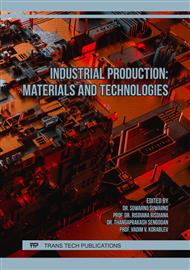p.47
p.67
p.83
p.91
p.99
p.107
p.113
p.123
p.129
Developing the Methodology of Failure Probability for the Rolling Equipment Units and Elements
Abstract:
The safety of basic parts of the rolling equipment is most at risk due to the complex geometrical shape and significant levels of nominal stresses. With a significant mass of such parts and a long production time, the replacement process is accompanied by the need to dismantle the old mill and install a new one. Currently, there are no specialized methods for assessing the risks of failures in relation to the rolling equipment, therefore, it is required to develop new methodological provisions and adapt the existing general methods of risk assessment to real production conditions. Based on the fundamentals of the regulatory document, a methodology for assessing the risks of failures in relation to the rolling equipment has been developed. The roughing stand of the “2000” hot rolling mill for titanium alloy sheet production was chosen as a practical object for assessing the risks of failure. The preliminary analysis of the dangers and their consequences had shown that for most of the elements of the working stand, which perceive the rolling force, as well as for the units and parts of the main drive loaded with the rolling torque, there are dangers that can lead to disruption of the deadlines for fulfilling orders for rolled products. For a numerical assessment of these risks, special calculations were performed.
Info:
Periodical:
Pages:
99-106
Citation:
Online since:
March 2023
Keywords:
Price:
Сopyright:
© 2023 Trans Tech Publications Ltd. All Rights Reserved
Share:
Citation:


